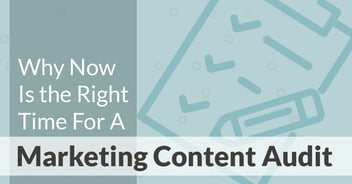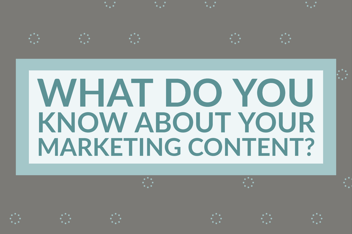Audit Your Current Marketing Content—What's Missing?
.jpg?width=2550&name=Audit%20Your%20Current%20Marketing%20Content%E2%80%94What's%20Missing_%20(1).jpg)
Q4 is almost here, and that means it is time to look ahead to what you want to accomplish in 2019 (and make the most of the time and resources — including marketing budget — remaining in 2018).
One of the most effective projects you could tackle now to set your team up to make an impact in 2019 is to audit your existing marketing content to find where there are holes that should be filled in the coming year. A marketing content audit can be performed internally, by completing an inventory of existing content and comparing it against previous campaign plans and best practices, or can involve working with an outside firm to take an unbiased look at what you are doing well and where there is room for improvement.
(Why you should be using audits to inform your next strategy.)
Regardless of who performs your marketing content audit, there are several key elements that should be considered. Let’s look at:
-
What to audit
-
What your marketing content should include
-
How to fill the gaps
What to audit when reviewing marketing content
Website
One of the most visible, and essential, components of an inbound marketing campaign is the company website. While you may be originally drawing traffic to your website through a business blog (which we’ll discuss in just a bit), it is important that the rest of the website be reviewed periodically. It is easy to continually update a blog and add new resources, while letting some web pages sit stagnant and potentially outdated.
Depending on how deep you want to go, a website audit could be as simple as reviewing key pages for obvious needed updates, such as changes to staffing on an About Us page or updated FAQs if some procedures and products have changed. Or you could take your website apart, page by page, to ensure that each page has essential elements in place for search engine optimization.
The person or team reviewing your website should also be aware of any glaring omissions on your website. Are you missing key pages that should be present to provide potential customers with all of the information they will want before engaging with a salesperson? After all, according to Forrester, nearly three-fourths of B2B buyers conduct at least half of their research online before making an offline purchase.
Blog posts
Review your business blog with an eye toward answering a few questions:
-
Are we publishing as often as we should be (or want to be)?
-
Are we focusing on the topics our customers are interested in? What topics are missing?
-
Are we writing customer-focused content rather than product-focused content?
-
Are we mixing up our blog post content with visuals and a variety of formats?
(Want a more specific checklist to help you determine whether your business blog is doing the right things? See how many of the 8 tips listed in our ebook you can check off. Download Business Blogging: Do This, Not That.)
Social media (including LinkedIn Publisher)
Another element you should consider in your marketing content audit is how your brand uses social media, both in promoting content such as blog posts, videos and lead generating offers and as a content channel on its own.
As with your business blog, consider your social media posting schedule and strategy. Are you posting with the frequency and formats your strategy calls for? Should that strategy be adjusted? Are you overlooking simple ways to extend your use of social media, such as repurposing business blog posts as articles for LinkedIn Publisher. (We’ve had great traffic on a couple of my Publisher posts, showing how well they complement the rest of our content strategy. Here are the two that have really taken off in the last few years: 53 Facts & Stats About Marketing Videos and Consider Your Options When Choosing Who Will Create Your Content.)
Gated material/landing pages
Another segment of your overall inbound marketing content strategy that should be inventoried on a regular basis and balanced against your overall goals, buyers’ journey and customer personas is your selection of lead generating offers. These assets, typically gated behind landing pages in order to capture online leads, can range from reports and whitepapers to ebook, checklists, webinars and case studies.
Review your list to see if there are topics of interest to your customers and prospects that are not addressed and if you are covering those topics in a variety of ways that provide useful and useable information for website visitors.
Find more resources on developing gated materials in these blog posts:
Nurturing material
While the other four content categories you have looked so far have largely revolved around the content designed to attract visitors (prospective customers) to your website, nurturing material is intended to continue your relationship with leads.
This includes:
Lead nurturing workflows — a series of emails to offer new leads additional information, bring them back to your website, and gather additional information about leads through progressive forms, helping you identify when a lead may be ready to transition to sales.
Assets for the middle of the sales funnel — examples include more in-depth reports, useable templates and calculators, and problem-solution papers.
Assets focused toward the bottom of the sales funnel — examples include case studies, customer testimonials, and pricing and product comparison guides.
Your lead nurturing workflows and assets should work together to create a cohesive campaign that continues the same topic and messaging throughout the buyers’ journey. (Download a successful example from our partner Primaris here: Creating A Winning Inbound Marketing Program.)
What your marketing content should include
As you inventory and review the content in each of the five channels outlined above, remember that in each, you should strive to develop content targeted for each stage of the sales funnel and for each of your buyer personas. This will help you move toward a comprehensive catalog of content to maximize your marketing efforts.
Content for all stages of the sales funnel
While there may be a few different terms or ways of considering the sales funnel (aka buyers’ journey or customer sales cycle), regardless of what you call it, the truth is that potential customers need different content at different points along the path to a sale. Your content should include something for each point along that path:
-
Awareness level content: A prospect or lead’s first introduction to your brand may be through an online search that uncovers a post on your business blog or may be through a contributed article in an industry publication or website.
-
Consideration level content: As B2B buyers actively search for solutions, they seek out material such as whitepapers or webinars to help them solve problems or address challenges.
-
Decision level content: Case studies and testimonials, along with product comparisons and other more sales-focused materials answer the more detailed questions decision makers have as they weigh their options.
Content for all personas
In addition to addressing each stage of the sales funnel, remember to create content for all of your customer personas. This includes each industry or niche you serve, but can also extend to considering the different needs of different decision makers involved in choosing a vendor.
For example, the CFO involved in the purchase decision may have different needs and a different perspective than the COO who will be putting the actual solution into use. Create content that addresses the needs and pain points of end users AND key decision makers — they may often be quite different.
(Learn more about the benefits of defining buyer personas here: Branding Mistakes — Not Mapping Out Buyer Personas.)
How to fill gaps in your marketing content
Once your marketing content audit is complete, you may find that you are hitting all of your targets, and just need to keep doing what you’ve been doing. Great!
But you may also find that there are gaps in your marketing content that need to be filled. How you go about filling those gaps will depend on the resources you have available.
Look for material that can be repurposed
If you are squeezed for resources — both in-house staff time and budget for any additional writers or outside contracts — the first place to look to ways to fill in gaps in your marketing content is to the content you already have. Existing materials can often be repurposed or updated without the full commitment of creating content from scratch.
If you have an in-depth report on a topic, but don’t have any awareness level content that addresses it, break the report down into smaller segments and rewrite it as blog posts, or share images and graphs from the report on social media with short commentary and a link.
If your content is text heavy, enlist a graphic artist to turn a longer ebook into a eye-catching infographic that provides the highlights in a new format. (Want to see what I mean? Check out our Email For Inbound: Do This, Not That ebook and the “Cliff’s Notes” version as a infographic.)
Assign in-house staff
If you have in-house staff with time available (maybe they’ve just wrapped up this year’s biggest projects), adding to your marketing content inventory can be a great way of finishing out the year. Don’t just dump the job on someone without understanding and explaining the purpose however — create a plan to use this new content in complete campaigns for the next year.
Find outside help for content creation
If you have budget, but not staff time, on your side, consider your options for finding outside help in creating the content needed to fill gaps in your current marketing. Options range from hiring new staff (though if your extra budget is a one-time allocation, that may not be a good option), contracting with freelance writers and designers, or choosing an agency to create to the content for you.
Things to consider in making that choice:
-
Do you already have an established relationship with outside contractors (freelancers or agencies)?
-
Do you want to manage and coordinate different elements of the content creation, including being the go-between linking different freelance professionals such as writers, video producers and graphic artists?
-
Are you looking for a contractor or agency that could take on additional projects in the future?
Check out these blog posts for more things to consider when choosing an agency or freelancer(s) for your marketing content creation:
Regardless of who completes the audit or creates the needed content, taking time to inventory all of your marketing content to find where you may need to fill in the gaps is a great way to finish out the year and take advantage of any remaining marketing budget before year’s end. Find 12 more ideas for using this year’s remaining budget to set your team up for success in the next fiscal year in this ebook: 13 Ways To Use Your End-of-Year Budget.
-1.png?width=1652&height=294&name=Jones(RGB)-1.png)

.jpg)










